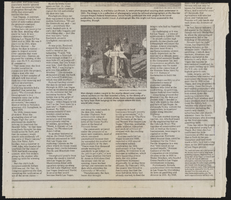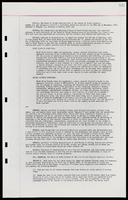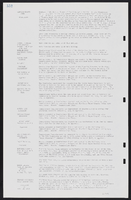Search the Special Collections and Archives Portal
Search Results
Susan Fine oral history interview
Identifier
Abstract
Oral history interview with Susan Fine conducted by Cecillia Boland on February 18, 1976 for the Ralph Roske Oral History Project on Early Las Vegas. Fine discusses her family background and moving to Boulder City, Nevada, and then later moving to Las Vegas, Nevada. She also discusses the educational system, church involvement, mercury test site, Howard Hughes’ impact to Las Vegas, Nevada, and Boulder (Hoover) Dam.
Archival Collection
measured drawings
drawings of an existing object, structure, or site, drawn to scale
Authority Sources
Material Type
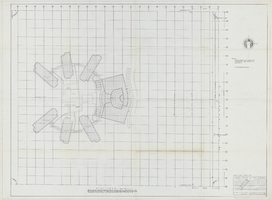
Architectural drawing of the Hacienda (Las Vegas), alternate plot plan, January 6, 1955
Date
Archival Collection
Description
Early plans for the Lady Luck, later the Hacienda. "VOID" written on the drawing. Drawn by: M.S. Original medium: pencil on paper.
Site Name: Hacienda
Address: 3590 Las Vegas Boulevard South
Image
Nellis Air Force Base: Dining Hall and Unaccompanied Enlisted Personnel Housing: Progress Prints, 1985 February 26; 1985 September 11
Level of Description
Scope and Contents
This set includes: preliminary sketches, process drawings, redlining, site plans, floor plans, topographic surveys, landscape plans, equipment plans, demolition plans, utility plans, exterior elevations, roof plans, building sections, foundation plans, framing plans, construction details, lighting plans, wall sections and index sheet.
This set includes drawings by Dobrusky Kittrell Garlock Architects (architect), Delta Engineering, Inc. (engineer), Strauss and Loftfield (engineer) and Harris Engineering, Inc (engineer).
Archival Collection
Collection Name: Gary Guy Wilson Architectural Drawings
Box/Folder: Roll 119
Archival Component
Hoover Dam, 1930-1965
Level of Description
Scope and Contents
Materials contain photographs of the Hoover Dam and surrounding areas from 1930 to 1965. The Hoover Dam, also known as the Boulder Dam, was constructed on the Colorado River in Black Canyon near Las Vegas, Nevada from 1931 to 1936 during the Great Depression. The dam impounds Lake Mead, the country's largest reservoir, and it provides hydroelectric power to Nevada, Arizona, and California.
Materials also include photographs of the Pueblo Grande de Nevada archaeological sites, also known as the "Lost City," which were partially covered by the waters of Lake Mead. The area originally belonged to Puebloan peoples. Additionally, the materials contain photographs of the town of St. Thomas, which was also submerged beneath Lake Mead.
Archival Collection
Collection Name: Elbert Edwards Photograph Collection
Box/Folder: N/A
Archival Component
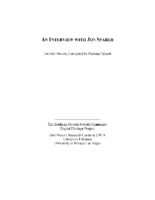
Transcript of interview with Jon Sparer by Barbara Tabach, March 4, 2015
Date
Archival Collection
Description
In this interview, Jon Sparer discusses his involvement as the architect of Congregation Ner Tamid's synagogue in Green Valley. He explains details of the building including the concrete tilt-up form, glass windows and the incorporation of quotes throughout the building. Sparer also discusses his involvement with the Gay and Lesbian Community Center of Southern Nevada (The Center) as a board member.
According to architect Jon Sparer, when he moved to Las Vegas in the early 1980s, the art of the deal was still based on a "handshake." It was just after the infamous MGM fire and Jon went to work for Rissman and Rissman. He later worked for Marnell Corrao Associates until 2001, and then as a principal in his own firm. He is now retired. While honing his design skills with the exciting transformation of the Strip into a world-class destination, Jon also became an active contributor to the Las Vegas community. Among his most notable experiences was being on the search committee for a new location for the fast growing Congregation Ner Tamid and then the architectural design for the synagogue's location in Henderson. It was a unique experience and Jon tells how he approached each aspect of the religious facility and how it would provide a memorable setting for life experiences. Jon has been involved with Jewish Family Services and the Anti-Defamation League (ADL). In addition, Jon along with his husband John Klai have been instrumental in the LGBTQ community and the opening of the Gay and Lesbian Community Center of Southern Nevada [The Center]. In this interview, he also talks about the significance of The Center/ and its success in working with the Clark County Health District, as well as providing a user-friendly experience for all who visit The Center and the Bronze Cafe located there.
Text
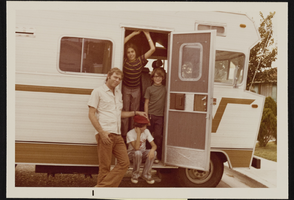
Mason Family, image 06, August 24-27, 1972
Description
First Mason family camping trip in motor home, August 24-27, 1972. Sites visited included Bryce Canyon, Zion, and the North Rim of the Grand Canyon.

